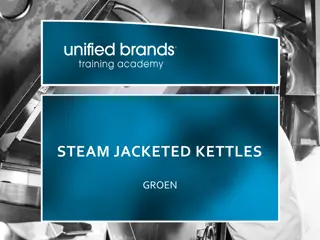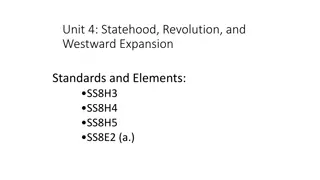Kettle Souring
Kettle souring is a method to sour wort in the brew kettle using Lactobacillus bacteria. The process involves steps like heating, chilling, acidifying, pitching LAB culture, boiling, and fermenting. Benefits include faster turnaround for sour beers and control over sourness levels. Equipment and heating options are essential for the process, and various sources for Lactic Acid Bacteria are available. Tips such as pre-acidifying wort and yeast selection are provided for a successful kettle souring experience.
Download Presentation

Please find below an Image/Link to download the presentation.
The content on the website is provided AS IS for your information and personal use only. It may not be sold, licensed, or shared on other websites without obtaining consent from the author.If you encounter any issues during the download, it is possible that the publisher has removed the file from their server.
You are allowed to download the files provided on this website for personal or commercial use, subject to the condition that they are used lawfully. All files are the property of their respective owners.
The content on the website is provided AS IS for your information and personal use only. It may not be sold, licensed, or shared on other websites without obtaining consent from the author.
E N D
Presentation Transcript
What is Kettle Souring? Method of souring wort in the brew kettle Souring generally accomplished by Lactobacillus bacteria Wort typically boiled after souring to kill LAB Different from, but similar to Mash Souring method
Kettle Sour Process 1. Wort is heated/boiled to kill off unwanted bugs 2. Wort is chilled to LAB-pitch temperature (115-86F) 3. (optional) Wort is pre-acidified to ~4.5 pH 4. LAB culture is pitched into wort, vessel is covered 5. In 12-72 hours (once desired acidity is reached), wort is boiled, hops added per recipe 6. Wort is chilled, transferred to fermenter and yeast is pitched 7. Beer is bottled or kegged and enjoyed!
Reasons for Kettle Souring Fast turnaround of sour beer (days/weeks vs. months/years) Keep cold side of the brewhouse clean Control of sourness level
Lactic Acid Bacteria Sources Commercial pitches WLP672 - L. brevis, WLP677 - L. delbrueckii Wyeast 5223 - L. brevis, Wyeast 5335 - L. buchneri Bootleg Biology, The Yeast Bay Probiotic drinks (Goodbelly) Probiotic pills Yogurt, Kefir, Yakult Grain Sauerkraut Sourdough starter
Equipment Kettle with lid - Stainless steel only. Aluminum pots should not be used below 4.5 pH. Can also use a fermenter, mash tun, etc. and plastic is also ok pH meter (or pH strips) - extremely helpful, but optional Temperature control - optional, depending on LAB culture Lactic Acid - helpful if you are pre-acidifying to 4.5pH pre-pitch
Heating Options Can use different methods pre-souring and post-souring Full boil - wort is boiled for 60 minutes like a normal brew Quick boil - wort is boiled for 5-15 minutes No Boil - wort brought to 175-190F for 5-15 minutes Note: not bringing wort to hot break before souring may result in hazy beer
Tips and Tricks Pre-acidify wort to 4.5 pH to prevent protease from destroying head retention proteins (also gives LAB a head start) Temperature control is not always required Each strain has its own optimal temperature range More heat can give faster souring, but can also impact flavor profile (just like yeast) Yeast choice is important due to highly acidic environment Known acid-tolerant strains: US05, S04, WY1098/WLP007/OYL-006, Belle Saison, Sacch Trois, WY3711, WY3726, most Brett strains, most Kolsch strains (also Kveik) Advisable to double your pitch rate vs. non-soured wort Can also use Acid Shock Starters Generally not required to purge headspace with CO2 Sour wort can suppress phenol and ester production in yeast strains and increase stress byproducts like diacetyl and sulphur compounds
Alternative Quick Souring Methods Co-pitch a. Brew low or unhopped wort, chill b. Pitch yeast and LAB c. Dry hop when desired sourness is reached (or don t) Reverse Pitch a. Brew low or unhopped wort, chill b. Pitch yeast c. After yeast fermentation is mostly complete, pitch LAB d. Dry hop when desired sourness is reached (or don t) Mash Souring a. LAB can be pitched in the mash tun before running off wort Lactic Acid a. Acid malt can be added in mass quantities to produce sour wort b. Lactic Acid can be directly added to sour wort/beer to desired level (squirt-squirt method)
Recipes Berlinerweiss 70% pilsner malt, 30% wheat Target 1.035-1.040 SG Sour to 3.5-3.2 pH During post-souring boil, add 1oz Hallertau @ 10 min Ferment with 2 packs US-05 or K-97 Gose 50% pilsner malt, 50% wheat Target 1.035-1.040 SG Sour to 3.5-3.2 pH During post-souring boil, add 1oz Hallertau @ 10 min Add 1oz crushed corriander and .5oz quality salt at flameout Ferment with 2 packs US-05 or K-97 Extract brewers: Substitute the grains for 5-6 lbs Wheat DME, or a blend of Wheat and Pilsner DME. Briess Wheat DME is 65% wheat, 35% barley.
Troubleshooting Quick Sours My wort is not souring in 18-48 hours Increase LAB pitch rate Ensure appropriate temperature for your LAB strain(s) Did you add more hops than your LAB can handle? Can add lactic acid to help overcome wort buffering My wort/beer smells like feet/diapers Check your sanitation/pasteurization procedures Ensure you are pitching a healthy LAB culture Try a different LAB culture (not all Lactobacillus are great for beer; same as Saccharomyces) Pitch Brettanomyces, it can convert isovaleric acid and butyric acid into fruity esters! My beer is too sour! Try blending with non-sour beer Add vanilla to temper acidity
More Troubleshooting Krausen on wort or LAB starter LAB will never produce a krausen Krausen is a sign of yeast infection, and is common in some commercial LAB pitches Diacetyl, sulphur flavors in beer Increase yeast pitch rate Try Acid Shock Starter Try a more acid-tolerant yeast strain Did you use Pediococcus? Add Brett There is a pellicle on my wort/LAB starter!! Chill out. Lactobacillus can produce a pellicle and it s no big deal There is no pellicle on my wort/LAB starter!! Chill out. Not all Lactobacillus strains produce pellicles My gravity didn t drop after kettle souring!! This is normal. LAB rarely consumes more than .002 gravity points
Additional References Milk The Funk Wiki: http://www.milkthefunk.com/wiki/Wort_Souring Sour Beer Blog: http://sourbeerblog.com Using probiotics in beer: https://suigenerisbrewing.blogspot.ca/2015/07/choosing-right-probiotics-for-souring.html Lactic Acid Bacteria Case Study: http://masterbrewerspodcast.com/085-lactic-acid-bacteria-case-study Master Brewers Conference Kettle Sour Presentation: http://www.craftbrewersconference.com/wp- content/uploads/2015_presentations/kettle_souring.pdf









